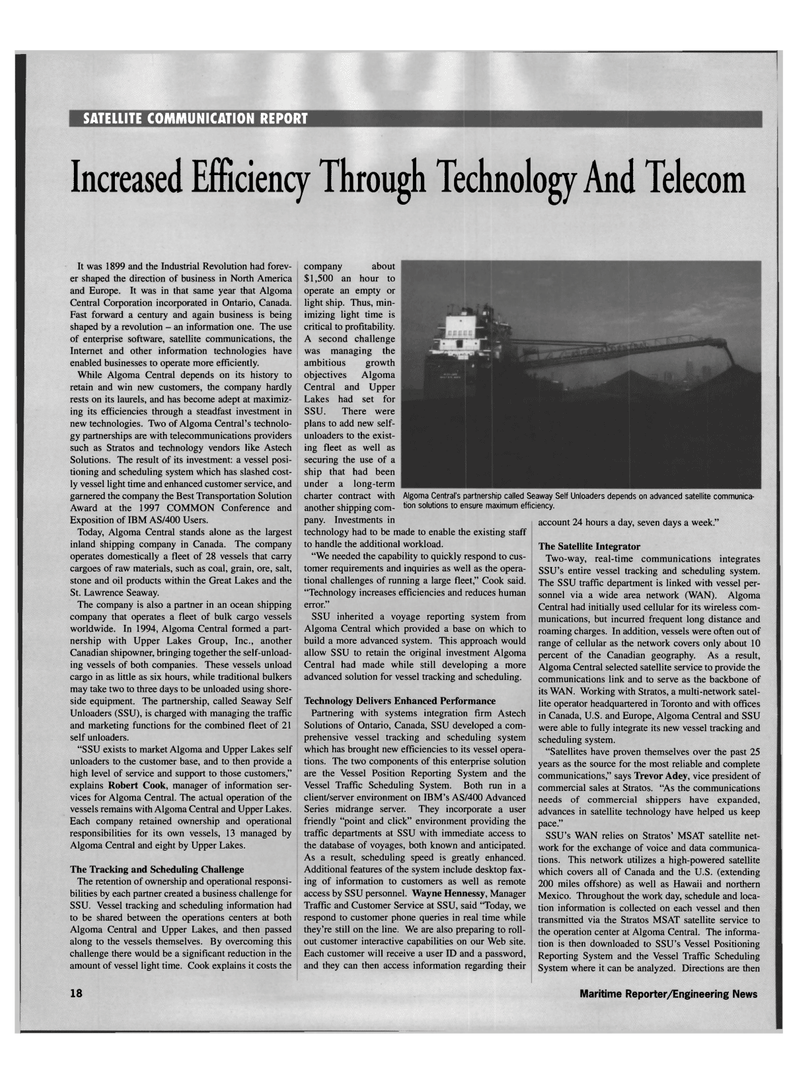
Page 18: of Maritime Reporter Magazine (March 1999)
Read this page in Pdf, Flash or Html5 edition of March 1999 Maritime Reporter Magazine
SATELLITE COMMUNICATION REPORT
Increased Efficiency Through Technology And Telecom
It was 1899 and the Industrial Revolution had forev- er shaped the direction of business in North America and Europe. It was in that same year that Algoma
Central Corporation incorporated in Ontario, Canada.
Fast forward a century and again business is being shaped by a revolution - an information one. The use of enterprise software, satellite communications, the
Internet and other information technologies have enabled businesses to operate more efficiently.
While Algoma Central depends on its history to retain and win new customers, the company hardly rests on its laurels, and has become adept at maximiz- ing its efficiencies through a steadfast investment in new technologies. Two of Algoma Central's technolo- gy partnerships are with telecommunications providers such as Stratos and technology vendors like Astech
Solutions. The result of its investment: a vessel posi- tioning and scheduling system which has slashed cost- ly vessel light time and enhanced customer service, and garnered the company the Best Transportation Solution
Award at the 1997 COMMON Conference and
Exposition of IBM AS/400 Users.
Today, Algoma Central stands alone as the largest inland shipping company in Canada. The company operates domestically a fleet of 28 vessels that carry cargoes of raw materials, such as coal, grain, ore, salt, stone and oil products within the Great Lakes and the
St. Lawrence Seaway.
The company is also a partner in an ocean shipping company that operates a fleet of bulk cargo vessels worldwide. In 1994, Algoma Central formed a part- nership with Upper Lakes Group, Inc., another
Canadian shipowner, bringing together the self-unload- ing vessels of both companies. These vessels unload cargo in as little as six hours, while traditional bulkers may take two to three days to be unloaded using shore- side equipment. The partnership, called Seaway Self
Unloaders (SSU), is charged with managing the traffic and marketing functions for the combined fleet of 21 self unloaders. "SSU exists to market Algoma and Upper Lakes self unloaders to the customer base, and to then provide a high level of service and support to those customers," explains Robert Cook, manager of information ser- vices for Algoma Central. The actual operation of the vessels remains with Algoma Central and Upper Lakes.
Each company retained ownership and operational responsibilities for its own vessels, 13 managed by
Algoma Central and eight by Upper Lakes.
The Tracking and Scheduling Challenge
The retention of ownership and operational responsi- bilities by each partner created a business challenge for
SSU. Vessel tracking and scheduling information had to be shared between the operations centers at both
Algoma Central and Upper Lakes, and then passed along to the vessels themselves. By overcoming this challenge there would be a significant reduction in the amount of vessel light time. Cook explains it costs the company about $1,500 an hour to operate an empty or light ship. Thus, min- imizing light time is critical to profitability.
A second challenge was managing the ambitious growth objectives Algoma
Central and Upper
Lakes had set for
SSU. There were plans to add new self- unloaders to the exist- ing fleet as well as securing the use of a ship that had been under a long-term charter contract with another shipping com- pany. Investments in technology had to be made to enable the existing staff to handle the additional workload. "We needed the capability to quickly respond to cus- tomer requirements and inquiries as well as the opera- tional challenges of running a large fleet," Cook said. "Technology increases efficiencies and reduces human error."
SSU inherited a voyage reporting system from
Algoma Central which provided a base on which to build a more advanced system. This approach would allow SSU to retain the original investment Algoma
Central had made while still developing a more advanced solution for vessel tracking and scheduling.
Technology Delivers Enhanced Performance
Partnering with systems integration firm Astech
Solutions of Ontario, Canada, SSU developed a com- prehensive vessel tracking and scheduling system which has brought new efficiencies to its vessel opera- tions. The two components of this enterprise solution are the Vessel Position Reporting System and the
Vessel Traffic Scheduling System. Both run in a client/server environment on IBM's AS/400 Advanced
Series midrange server. They incorporate a user friendly "point and click" environment providing the traffic departments at SSU with immediate access to the database of voyages, both known and anticipated.
As a result, scheduling speed is greatly enhanced.
Additional features of the system include desktop fax- ing of information to customers as well as remote access by SSU personnel. Wayne Hennessy, Manager
Traffic and Customer Service at SSU, said "Today, we respond to customer phone queries in real time while they're still on the line. We are also preparing to roll- out customer interactive capabilities on our Web site.
Each customer will receive a user ID and a password, and they can then access information regarding their
Algoma Central's partnership called Seaway Self Unloaders depends on advanced satellite communica- tion solutions to ensure maximum efficiency. account 24 hours a day, seven days a week."
The Satellite Integrator
Two-way, real-time communications integrates
SSU's entire vessel tracking and scheduling system.
The SSU traffic department is linked with vessel per- sonnel via a wide area network (WAN). Algoma
Central had initially used cellular for its wireless com- munications, but incurred frequent long distance and roaming charges. In addition, vessels were often out of range of cellular as the network covers only about 10 percent of the Canadian geography. As a result,
Algoma Central selected satellite service to provide the communications link and to serve as the backbone of its WAN. Working with Stratos, a multi-network satel- lite operator headquartered in Toronto and with offices in Canada, U.S. and Europe, Algoma Central and SSU were able to fully integrate its new vessel tracking and scheduling system. "Satellites have proven themselves over the past 25 years as the source for the most reliable and complete communications," says Trevor Adey, vice president of commercial sales at Stratos. "As the communications needs of commercial shippers have expanded, advances in satellite technology have helped us keep pace."
SSU's WAN relies on Stratos' MSAT satellite net- work for the exchange of voice and data communica- tions. This network utilizes a high-powered satellite which covers all of Canada and the U.S. (extending 200 miles offshore) as well as Hawaii and northern
Mexico. Throughout the work day, schedule and loca- tion information is collected on each vessel and then transmitted via the Stratos MSAT satellite service to the operation center at Algoma Central. The informa- tion is then downloaded to SSU's Vessel Positioning
Reporting System and the Vessel Traffic Scheduling
System where it can be analyzed. Directions are then 18 Maritime Reporter/Engineering News

 17
17

 19
19
